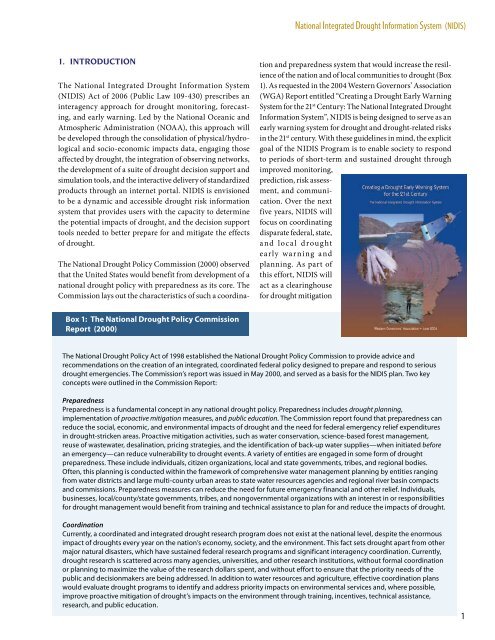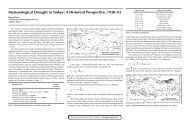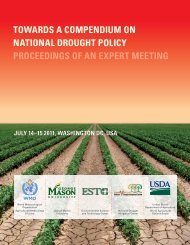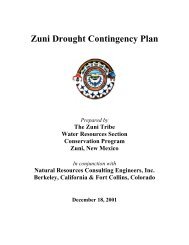Table of Contents - National Drought Mitigation Center - The ...
Table of Contents - National Drought Mitigation Center - The ...
Table of Contents - National Drought Mitigation Center - The ...
You also want an ePaper? Increase the reach of your titles
YUMPU automatically turns print PDFs into web optimized ePapers that Google loves.
1. IntroductIon<br />
<strong>The</strong> <strong>National</strong> Integrated <strong>Drought</strong> Information System<br />
(NIDIS) Act <strong>of</strong> 2006 (Public Law 109-430) prescribes an<br />
interagency approach for drought monitoring, forecasting,<br />
and early warning. Led by the <strong>National</strong> Oceanic and<br />
Atmospheric Administration (NOAA), this approach will<br />
be developed through the consolidation <strong>of</strong> physical/hydrological<br />
and socio-economic impacts data, engaging those<br />
affected by drought, the integration <strong>of</strong> observing networks,<br />
the development <strong>of</strong> a suite <strong>of</strong> drought decision support and<br />
simulation tools, and the interactive delivery <strong>of</strong> standardized<br />
products through an internet portal. NIDIS is envisioned<br />
to be a dynamic and accessible drought risk information<br />
system that provides users with the capacity to determine<br />
the potential impacts <strong>of</strong> drought, and the decision support<br />
tools needed to better prepare for and mitigate the effects<br />
<strong>of</strong> drought.<br />
<strong>The</strong> <strong>National</strong> <strong>Drought</strong> Policy Commission (2000) observed<br />
that the United States would benefit from development <strong>of</strong> a<br />
national drought policy with preparedness as its core. <strong>The</strong><br />
Commission lays out the characteristics <strong>of</strong> such a coordina-<br />
Box 1: <strong>The</strong> <strong>National</strong> <strong>Drought</strong> Policy Commission<br />
Report (2000)<br />
<strong>National</strong> Integrated <strong>Drought</strong> Information System (NIDIS)<br />
tion and preparedness system that would increase the resilience<br />
<strong>of</strong> the nation and <strong>of</strong> local communities to drought (Box<br />
1). As requested in the 2004 Western Governors’ Association<br />
(WGA) Report entitled “Creating a <strong>Drought</strong> Early Warning<br />
System for the 21 st Century: <strong>The</strong> <strong>National</strong> Integrated <strong>Drought</strong><br />
Information System”, NIDIS is being designed to serve as an<br />
early warning system for drought and drought-related risks<br />
in the 21 st century. With these guidelines in mind, the explicit<br />
goal <strong>of</strong> the NIDIS Program is to enable society to respond<br />
to periods <strong>of</strong> short-term and sustained drought through<br />
improved monitoring,<br />
prediction, risk assessment,<br />
and communication.<br />
Over the next<br />
five years, NIDIS will<br />
focus on coordinating<br />
disparate federal, state,<br />
a nd loca l d roug ht<br />
early warning and<br />
planning. As part <strong>of</strong><br />
this effort, NIDIS will<br />
act as a clearinghouse<br />
for drought mitigation<br />
<strong>The</strong> <strong>National</strong> <strong>Drought</strong> Policy Act <strong>of</strong> 1998 established the <strong>National</strong> <strong>Drought</strong> Policy Commission to provide advice and<br />
recommendations on the creation <strong>of</strong> an integrated, coordinated federal policy designed to prepare and respond to serious<br />
drought emergencies. <strong>The</strong> Commission’s report was issued in May 2000, and served as a basis for the NIDIS plan. Two key<br />
concepts were outlined in the Commission Report:<br />
Preparedness<br />
Preparedness is a fundamental concept in any national drought policy. Preparedness includes drought planning,<br />
implementation <strong>of</strong> proactive mitigation measures, and public education. <strong>The</strong> Commission report found that preparedness can<br />
reduce the social, economic, and environmental impacts <strong>of</strong> drought and the need for federal emergency relief expenditures<br />
in drought-stricken areas. Proactive mitigation activities, such as water conservation, science-based forest management,<br />
reuse <strong>of</strong> wastewater, desalination, pricing strategies, and the identification <strong>of</strong> back-up water supplies—when initiated before<br />
an emergency—can reduce vulnerability to drought events. A variety <strong>of</strong> entities are engaged in some form <strong>of</strong> drought<br />
preparedness. <strong>The</strong>se include individuals, citizen organizations, local and state governments, tribes, and regional bodies.<br />
Often, this planning is conducted within the framework <strong>of</strong> comprehensive water management planning by entities ranging<br />
from water districts and large multi-county urban areas to state water resources agencies and regional river basin compacts<br />
and commissions. Preparedness measures can reduce the need for future emergency financial and other relief. Individuals,<br />
businesses, local/county/state governments, tribes, and nongovernmental organizations with an interest in or responsibilities<br />
for drought management would benefit from training and technical assistance to plan for and reduce the impacts <strong>of</strong> drought.<br />
Coordination<br />
Currently, a coordinated and integrated drought research program does not exist at the national level, despite the enormous<br />
impact <strong>of</strong> droughts every year on the nation’s economy, society, and the environment. This fact sets drought apart from other<br />
major natural disasters, which have sustained federal research programs and significant interagency coordination. Currently,<br />
drought research is scattered across many agencies, universities, and other research institutions, without formal coordination<br />
or planning to maximize the value <strong>of</strong> the research dollars spent, and without effort to ensure that the priority needs <strong>of</strong> the<br />
public and decisionmakers are being addressed. In addition to water resources and agriculture, effective coordination plans<br />
would evaluate drought programs to identify and address priority impacts on environmental services and, where possible,<br />
improve proactive mitigation <strong>of</strong> drought’s impacts on the environment through training, incentives, technical assistance,<br />
research, and public education.<br />
1








